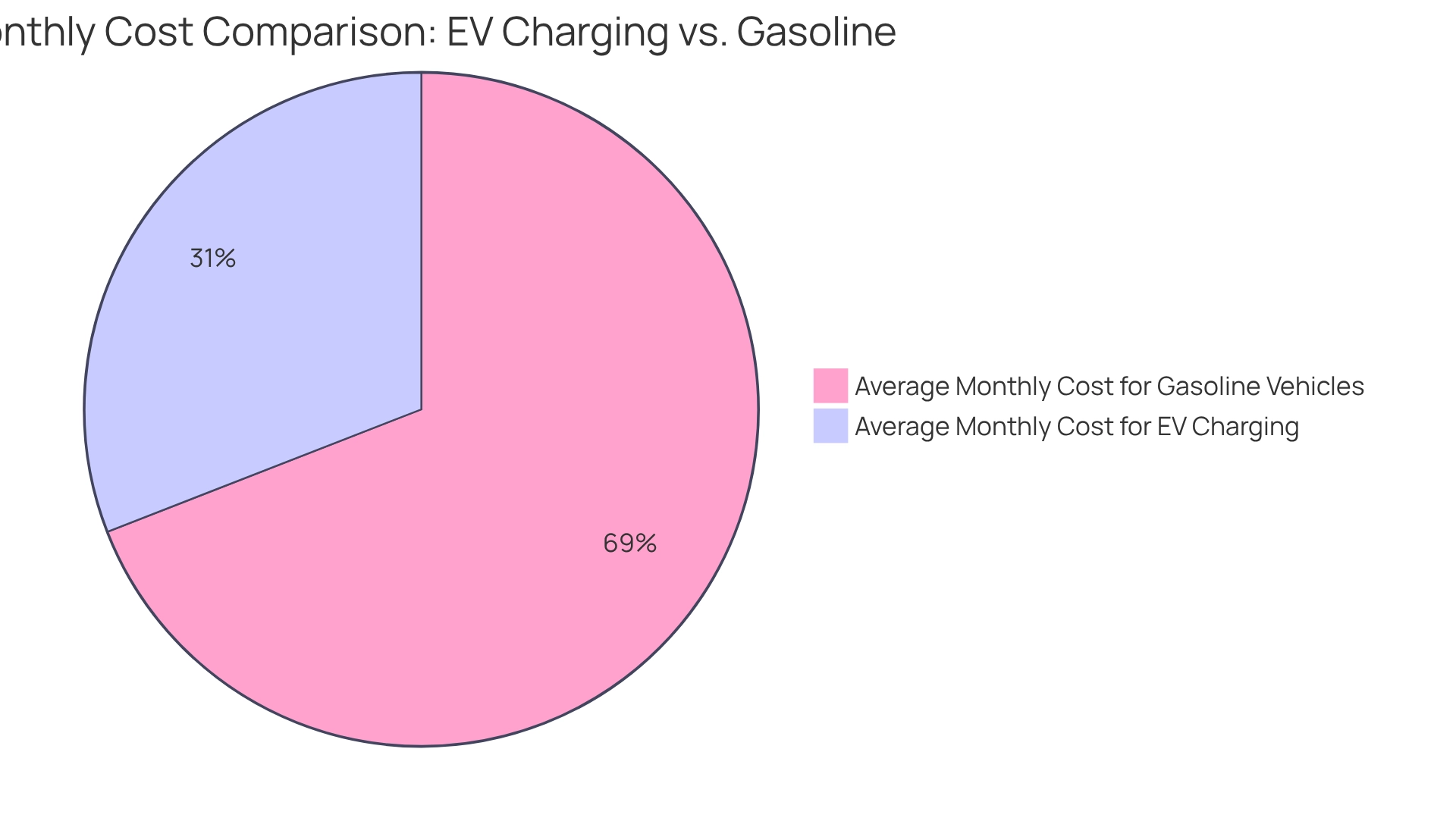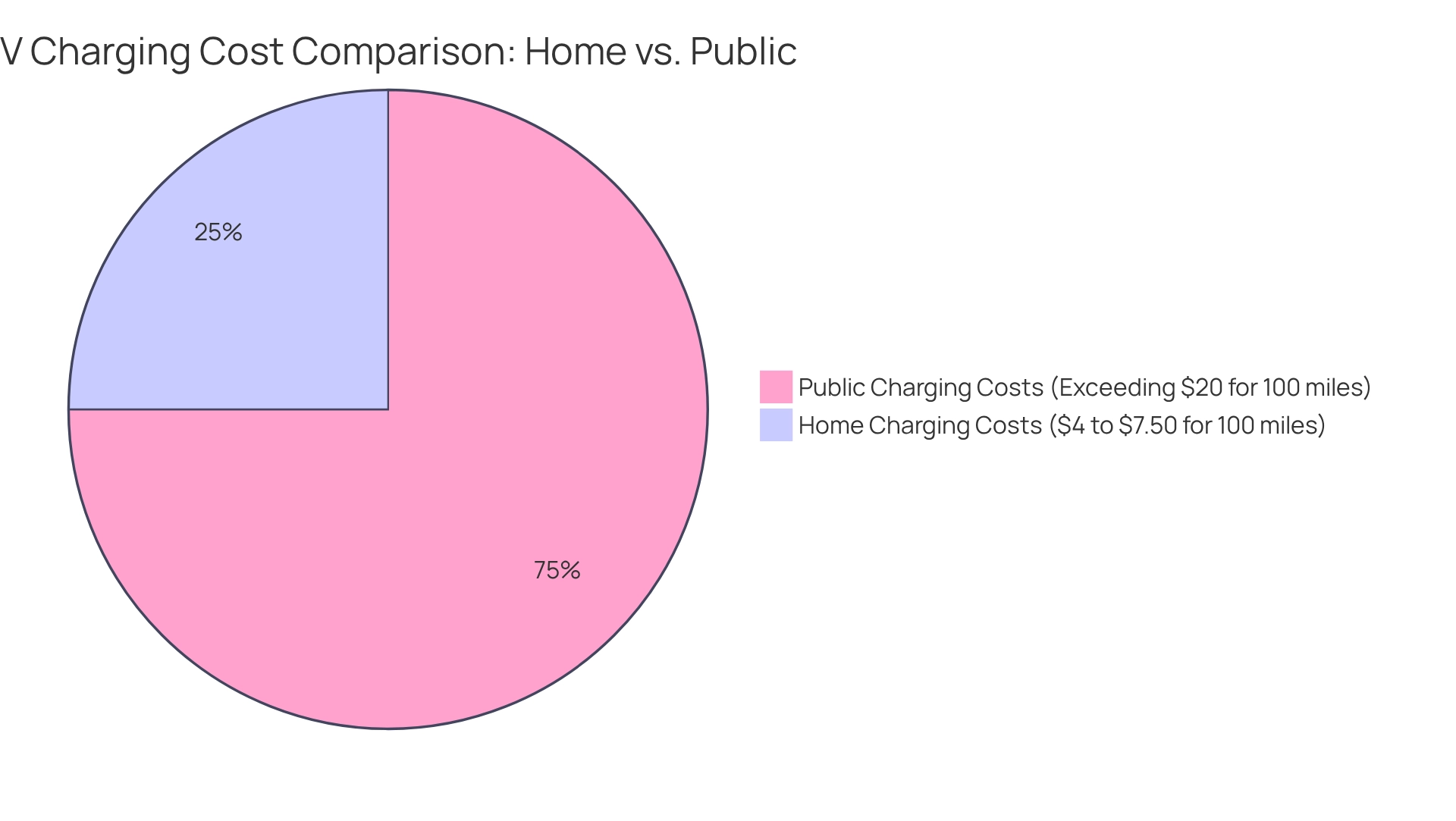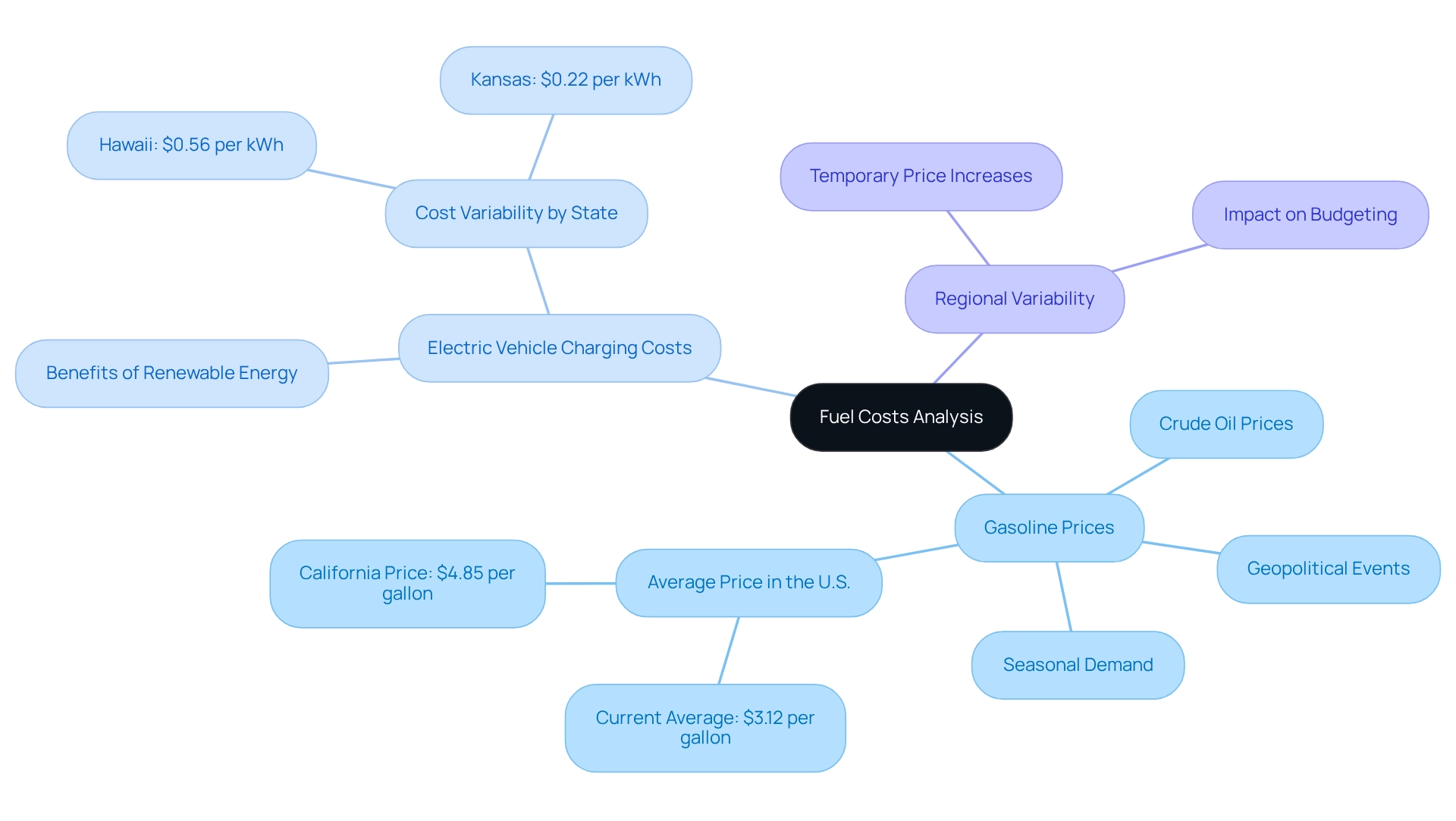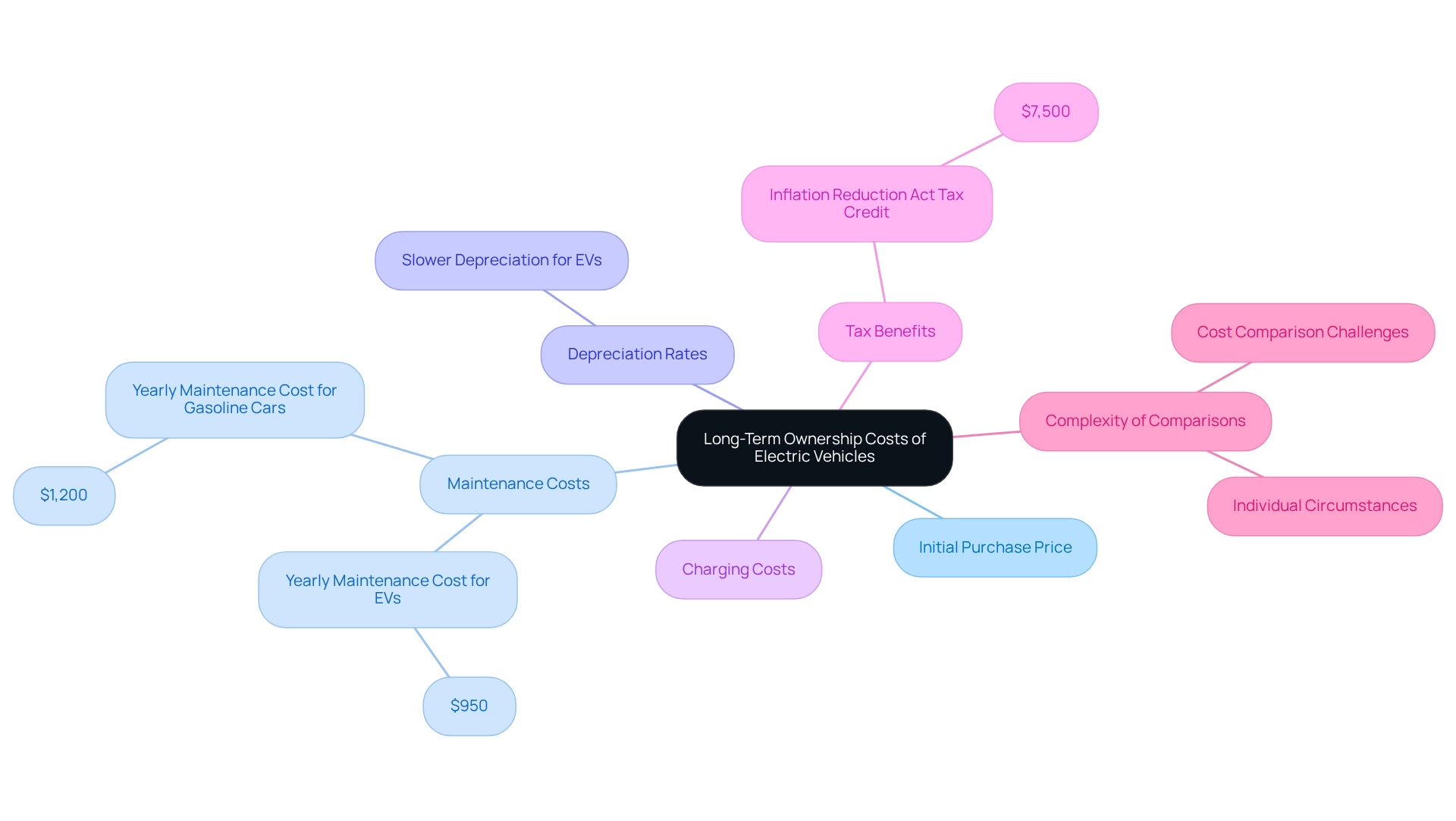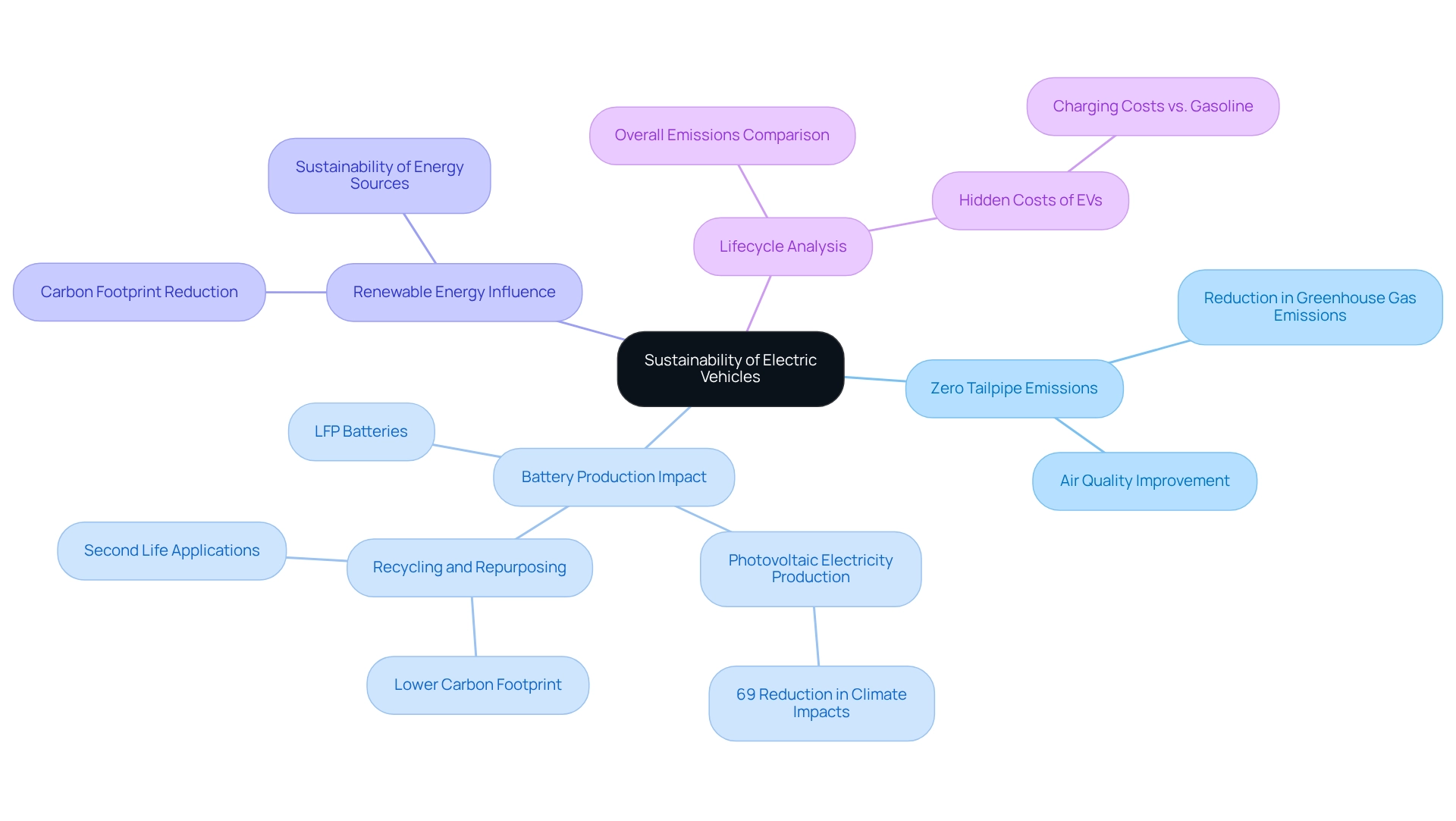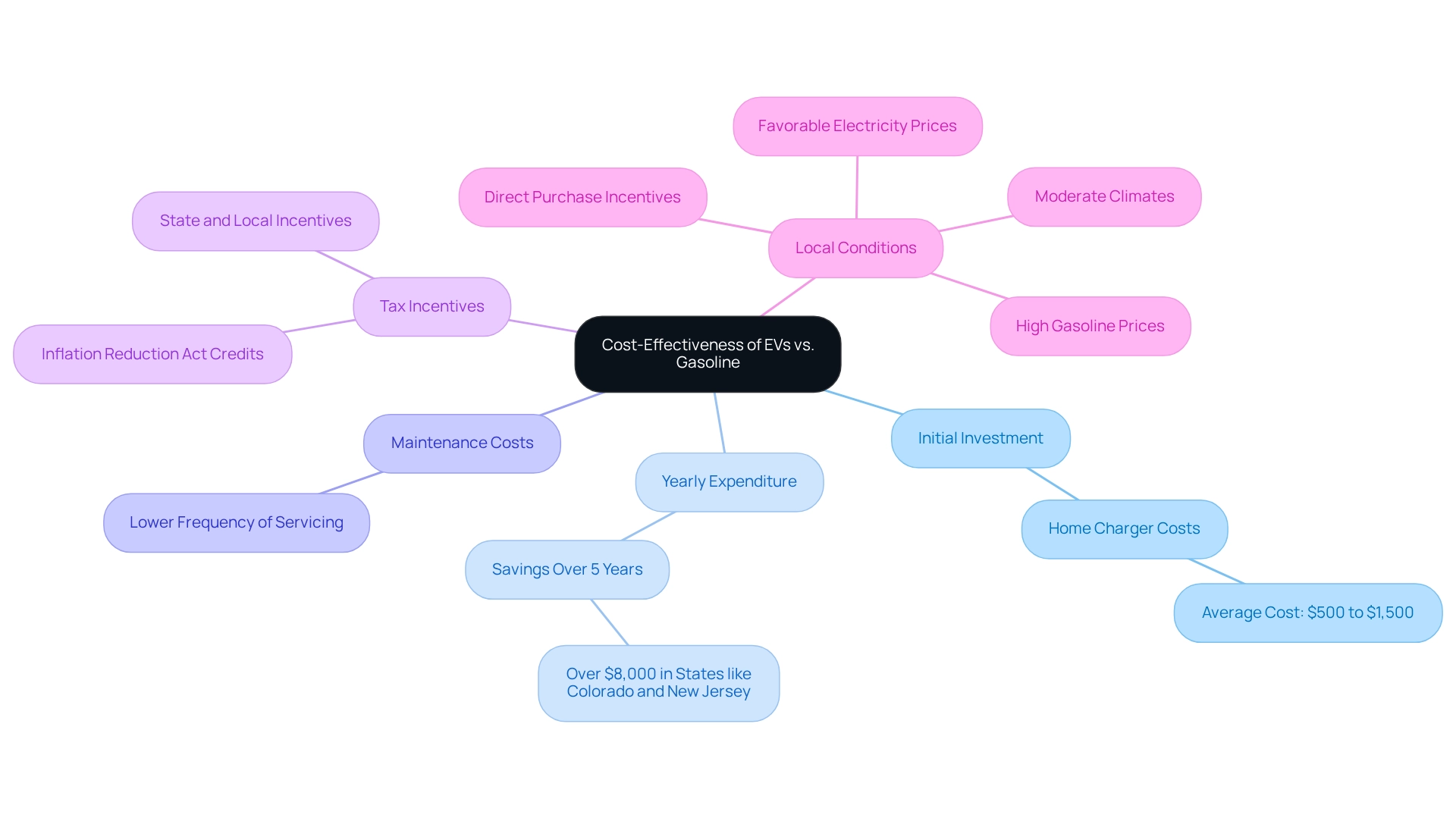Overview
We understand that managing energy bills can be a significant concern for many homeowners. The good news is that the cost to charge an electric vehicle (EV) is significantly lower than the expenses associated with gasoline vehicles. On average, monthly charging costs for EVs are around $70.72, compared to $158 for gasoline cars. This difference not only alleviates financial pressure but also opens the door to a more sustainable lifestyle.
By considering local electricity rates and the lower maintenance costs of EVs, it’s clear that choosing electric transportation can lead to long-term savings. Additionally, various financial incentives are available, making EV ownership even more economical over time. Together, we can embrace these changes and enjoy the environmental benefits that come with them.
It’s common to feel overwhelmed by the choices available, but rest assured, the shift towards electric vehicles is a step towards energy independence and a healthier planet. Let’s work towards a brighter future, where sustainable solutions are within reach for everyone.
Introduction
In a world that increasingly prioritizes sustainability and cost efficiency, the conversation surrounding electric vehicles (EVs) versus traditional gasoline-powered cars resonates deeply with many of us. We understand that fluctuating fuel prices and growing environmental concerns can weigh heavily on your decision-making. Thus, it becomes essential to grasp the financial implications of both options.
From the lower monthly charging costs of EVs to the often-overlooked expenses associated with gasoline vehicles, the financial landscape is in flux. This article aims to explore the intricate cost dynamics of EV ownership, examining everything from charging expenses and long-term maintenance to the environmental benefits that come with embracing electric mobility.
As eco-conscious consumers, seeking to make informed choices, the insights provided here will illuminate the path toward a more sustainable and economically viable future. Together, we can navigate these choices with confidence and care.
Understanding the Cost Dynamics: EV Charging vs. Gasoline
The expense dynamics of the cost to charge an EV versus gasoline are influenced by several factors, including local electricity rates, gasoline prices, and vehicle efficiency. We understand that many homeowners are concerned about rising energy bills. In California, the typical expense to charge an EV at home is around $70.72 per month, which is considerably lower than the average monthly outlay of $158 for a gasoline vehicle. This significant difference highlights the potential savings for EV owners, particularly when evaluating the cost to charge an EV versus gasoline, especially considering the unpredictable nature of gas prices that can vary greatly depending on geographic location and market conditions.
Furthermore, when considering the cost to charge an EV versus gasoline, powering an EV at home can be even more cost-effective, especially given the current electricity rates. For example, with Electrify America Pass Pricing established at 64 cents per kWh at DC fast chargers, the expense of charging remains competitive. It’s common to feel overwhelmed by the costs associated with traditional vehicles; however, the cost to charge an EV versus gasoline reveals that gasoline automobiles incur extra expenses from regular upkeep, which can elevate yearly expenditures by approximately 35% relative to EVs.
Essential services for gasoline vehicles, including oil changes, tire rotations, and brake maintenance, contribute to this higher expense. This further emphasizes the cost to charge an EV versus gasoline and the financial benefits of EV ownership.
Real-world examples illustrate these savings effectively. Homeowners who transition to EVs not only benefit from lower fueling expenses but also assist in decreasing carbon emissions and enhancing public health. As Shelia Hu noted, ‘From renewable energy breakthroughs to key policy wins, climate change progress is happening—but it’s under threat.’ This highlights the importance of transitioning to sustainable energy practices.
Powercore Electric supports this transition by providing solar energy solutions and EV charging installations, including Level 2 and Level 3 chargers that cater to various homeowner needs. By incorporating solar solutions, like solar water heaters that provide substantial savings on utility expenses and lessen dependence on non-renewable resources, homeowners can tackle increasing energy expenses and improve their overall savings.
Together, we can make EVs an appealing choice for eco-conscious consumers seeking to save on energy expenses while protecting the environment. Let’s work towards a more sustainable future, where your choices contribute to both your savings and the health of our planet.
Breaking Down EV Charging Costs: Home vs. Public Charging
Replenishing your electric vehicle (EV) can be a convenient choice, whether you opt for home charging or public stations. It’s important to understand the notable price differences between these options, especially when considering your energy bills. In California, home refueling typically ranges from $0.13 to $0.25 per kWh, influenced by local electricity rates. For instance, powering your EV to cover 100 miles may cost between $4 and $7.50 at home.
We understand that managing energy expenses is a concern for many homeowners. If you have solar panels, you can significantly lower your electricity bills and reduce reliance on the grid. Powercore Electric offers sophisticated, budget-friendly solar options designed to optimize your savings, helping you reduce energy expenses with customized solar systems. Together, we can make your energy costs more manageable.
On the other hand, public power stations, particularly rapid chargers, can charge fees as high as $0.50 per kWh. This could lead to expenses exceeding $20 for the same distance. Recent evaluations of public EV refueling expenses show that in February 2025, the weighted average pay-as-you-go (PAYG) rate for slow and fast devices was roughly 52p/kWh, while rapid and ultra-rapid devices averaged 80p/kWh. Despite variations in previous years, these statistics suggest that EV operators still enjoy lower expenses when comparing the cost to charge EVs versus gasoline vehicles.
It’s common to feel uncertain about charging costs before connecting. Nick Kurczewski, an automotive writer, emphasizes the importance of inquiring about recharging expenses. Homeowners can take advantage of off-peak power at home, utilize free EV charging options available at workplaces or shopping centers, and maximize local incentives to significantly enhance savings by understanding the cost to charge EVs versus gas.
Furthermore, power gullies provide a secure option for home EV replenishment, even without a driveway, facilitating the adoption of this sustainable practice for homeowners.
By incorporating solar energy solutions into your replenishment practices, you can make home charging not only a convenient choice but also a financially wise one. Powercore Electric’s in-house team of experts ensures high-quality installations and maintenance, reinforcing our commitment to providing effective home charging solutions. Ready to save on your energy bills?
Get your free, personalized estimate now!
Analyzing Fuel Costs for Gas-Powered Vehicles
Gasoline prices can be a source of stress for many, often fluctuating due to various factors such as crude oil prices, geopolitical events, and seasonal demand changes. As of April 2025, the average price for regular gasoline in the United States is approximately $3.12 per gallon. For those driving a car that averages 25 miles per gallon, this translates to an annual fuel cost of around $1,200, based on a typical driving distance of 15,000 miles.
However, we understand that this expense can vary significantly from one area to another. For example, California residents are currently facing prices as high as $4.85 per gallon, which can substantially increase their annual fuel expenses. Recent updates indicate temporary price hikes across various regions, complicating budgeting for consumers. These fluctuations not only lead to unpredictable monthly expenses for gas-powered car owners but also underscore the financial risks associated with the cost of charging electric vehicles versus gasoline and the volatility of gasoline prices.
In contrast, the expenses related to charging battery-powered vehicles, especially when comparing the cost of charging electric vehicles versus gasoline, tend to be more stable. This stability can provide a more predictable budgeting scenario for eco-conscious buyers. By integrating battery-powered vehicles with renewable energy sources, homeowners can enhance their savings and sustainability efforts. Powercore Electric emphasizes that understanding the dynamics of fuel expenses is crucial for making informed decisions about vehicle ownership.
Moreover, the cost of charging electric vehicles compared to gasoline varies widely. For instance, Hawaii faces the highest rates at 56 cents per kilowatt-hour for EVs, while Kansas offers the lowest at 22 cents. This variability highlights the importance of evaluating solar service providers to find the best value in solar energy solutions, which can significantly reduce charging costs and promote sustainable driving.
Together, we can navigate these challenges and explore more stable, eco-friendly energy solutions that not only alleviate financial burdens but also contribute to a sustainable future.
Long-Term Ownership Costs of Electric Vehicles: What to Expect
Although the initial purchase price of EVs may be higher than that of gasoline cars, we understand that analyzing the cost to charge EVs versus gas reveals a strong benefit for EVs, especially when considering long-term ownership expenses. Maintenance expenses for EVs are typically lower, thanks to their simpler mechanics and fewer moving parts. For instance, the typical yearly maintenance expense for an EV is around $950, in contrast to $1,200 for a gasoline car. This difference underscores the financial benefits of choosing an EV, allowing you to feel more secure about your investment.
Furthermore, EVs typically experience slower depreciation rates, particularly as consumer demand for battery-powered transport continues to grow. This trend is especially significant in 2025, as the market shifts towards more sustainable options. During a five-year possession term, the overall cost to charge EVs versus gas can be significantly less than that of a gasoline vehicle, particularly when considering fuel savings and available tax benefits.
The Inflation Reduction Act, for example, offers up to $7,500 in tax credits for qualifying EV purchases, further enhancing the financial attractiveness of battery-powered transport. It’s common to feel overwhelmed by the complexities involved in comparing the cost to charge EVs versus gas—given that many EVs lack direct gasoline counterparts—but the consensus among experts is clear: owning an EV is often more economical in the long run. As Courtney Lindwall points out, “Evaluating the overall expense of ownership for five of the most favored internal combustion models across various categories and contrasting each to a similarly sized battery-powered version, the study discovered that possessing an EV would consistently be less expensive.” This understanding, along with practical instances of upkeep expenses, strengthens the idea that shifting to electric transportation not only promotes environmentally friendly decisions but also results in significant savings over time.
Additionally, the case study titled ‘Cost Comparison Challenges’ highlights the difficulties in comparing the cost to charge EVs versus gas vehicles, noting that this comparison process is complex and varies based on individual circumstances. This complexity further emphasizes the importance of seeking advice from specialists, like those from Powercore Electric, whose in-house team guarantees high-quality installations and upkeep of EV power stations and solar energy solutions. With over 30 years of experience serving California, Powercore Electric is committed to exceptional service and community support, making them a trusted partner for homeowners looking to enhance their energy efficiency and sustainability.
Customer testimonials further illustrate this commitment: “Ryan and his team were great. They were fast, efficient, and stayed on schedule for our solar installation. I have referred Powercore to some friends, and they were also happy with their service. I’d definitely recommend Ryan and Powercore Electric.” This feedback highlights the satisfaction of clients who have benefited from Powercore Electric’s services. Furthermore, detailed pricing information for EV charging solutions and solar panels can provide homeowners with a clearer understanding of the financial implications of their choices, reinforcing the value of consulting with Powercore Electric for tailored solutions.
Exploring Financial Incentives for Electric Vehicle Owners
A range of financial incentives is designed to encourage the use of electric vehicles (EVs) throughout the United States. We understand that the initial investment can be daunting; however, federal tax credits can offer up to $7,500 for qualifying new EV purchases, significantly lowering the upfront costs. Alongside federal assistance, numerous states, including California, provide additional incentives. For instance, California offers rebates of up to $2,000 for qualifying eco-friendly cars, making the transition to EV ownership even more appealing.
These incentives not only alleviate initial expenses but also enhance the overall financial feasibility of owning an electric vehicle when considering the cost to charge EVs versus gasoline. Moreover, utility companies frequently provide discounts for recharging during off-peak hours, which can lead to substantial savings on electricity bills.
Looking ahead to 2025, California continues to lead with robust EV rebates and incentives, ensuring that eco-conscious homeowners can reap the benefits of both state and federal programs. For example, the installation of residential power stations, such as Tesla Level 2 chargers, may qualify for the Alternative Fuel Vehicle Refueling Property Tax Credit, helping to reduce installation costs and potentially increasing property value. The average cost of installing a Tesla Level 2 home charger ranges from $1,200 to $2,500, depending on the complexity of the installation and local labor rates.
Powercore Electric is here to offer comprehensive EV charging solutions that not only facilitate this transition but also align with sustainable energy practices.
Furthermore, practical EV6 variants are anticipated to have a range of 313 miles, showcasing the efficiency and convenience of battery-powered transportation. As the landscape of EV ownership evolves, the financial incentives available are becoming increasingly attractive, particularly when evaluating the cost to charge EVs versus gasoline. This makes it easier for homeowners to embrace sustainable energy solutions while enjoying significant savings. Notably, to qualify for the $3,750 critical minerals credit, a portion of the minerals in the battery must be sourced from the U.S. or a country with a free trade agreement, with thresholds increasing from 40% in 2023 to 80% by 2027 through 2032.
As Jack Fitzgerald, an Associate News Editor, observes, “His new aim is to postpone the unavoidable end of his 2010 Volkswagen Golf,” reflecting the growing interest in transitioning to battery-powered transportation. The evolving incentives and credits are making the shift to EV ownership more financially accessible for homeowners. Are you prepared to make the transition to battery-powered transportation?
Contact Powercore Electric today to learn more about our EV charging solutions and how we can support you in embracing a cleaner, more sustainable future.
Cost and Environmental Impact: A Sustainable Perspective
The ecological influence of electric vehicles (EVs) compared to gasoline cars is a significant consideration for many consumers today. We understand that the choice between these options can be daunting, especially when it comes to their environmental impact. EVs are celebrated for producing zero tailpipe emissions, which greatly contributes to improved air quality and a reduction in greenhouse gas emissions. While it’s true that the production of EV batteries carries an environmental cost, research shows that over their entire lifecycle, EVs generally yield lower overall emissions compared to their gasoline counterparts.
For instance, when powered by renewable energy sources, an EV can achieve a carbon footprint that is significantly lower than that of a gasoline car, even after considering the emissions associated with electricity production. This perspective on sustainability is increasingly vital as consumers become more conscious of their environmental footprint. Moreover, all modes of transport, including EVs, must comply with Federal Motor Safety Standards, ensuring safety through comprehensive testing.
Advancements in battery technology, such as lithium iron phosphate (LFP) batteries, have been shown to produce lower emissions per kilowatt-hour compared to other types, enhancing the overall environmental benefits of EVs. Notably, producing batteries with photovoltaic electricity reduces climate impacts by 69 percent, underscoring the sustainability of EV battery production. Practical examples demonstrate that recycling and repurposing old EV batteries can significantly lower the carbon footprint related to battery production, further reinforcing the argument for battery-powered transport as a more sustainable option in 2025 and beyond.
As Trancik observes, it’s crucial to inquire about the concealed expenses of EVs, particularly the cost to charge EVs versus gasoline vehicles. However, these concerns have been thoroughly addressed, with numerous organizations affirming that EVs continue to surpass gasoline autos. Together, we can explore these options and support each other in making informed decisions for a more sustainable future.
Conclusion: Which is More Cost-Effective—Charging an EV or Gasoline?
While the initial investment in electric transportation may feel daunting, we understand that the long-term financial advantages often outweigh these upfront costs. The typical yearly expenditure for charging an EV is significantly lower than refueling a gasoline car, with research indicating that EV owners can save over $8,000 in total ownership expenses over five years in states like Colorado and New Jersey. This substantial savings is further enhanced by lower maintenance costs, as EVs generally require less frequent servicing than their gasoline counterparts.
Moreover, the environmental benefits of transitioning to an EV are compelling. For instance, the Tesla Model 3 becomes less harmful to the environment than a Toyota Corolla after just 13,500 miles, showcasing the positive impact of battery-powered vehicles on carbon emissions and public health.
Tax incentives also make EV ownership more financially appealing. The Inflation Reduction Act provides significant tax credits for EV purchases, allowing consumers to substantially reduce their initial expenses. When combined with state and local incentives, these financial benefits make the move to an electric vehicle even more attractive.
When considering the installation of a home Tesla charger, it’s important to note that costs can vary based on the specific model and installation requirements. On average, homeowners can expect to invest between $500 to $1,500 for a Level 2 home charger, depending on the complexity of the installation and any necessary electrical upgrades.
Expert evaluations support the idea that cities with favorable conditions for EVs—such as low electricity prices and high gasoline rates—often see higher adoption rates. As Woody observes, “Cities that are especially welcoming for [EVs] share various characteristics, including an affordable price of electricity, high gasoline prices, moderate climates, and direct purchase incentives.” This trend underscores the importance of local factors in assessing the overall cost of charging EVs versus gasoline for powered transport.
In summary, the combination of lower energy costs, reduced maintenance expenses, and available tax incentives positions electric vehicles as a financially savvy choice for eco-conscious homeowners in 2025. Together, we can assist you in making the shift to a cleaner, more sustainable future. Consider Powercore Electric’s EV power solutions, which include expert installation and ongoing support. Ready to embrace this change?
Contact Powercore Electric today to learn more about how we can support you and provide a quote for your home charging needs.
Conclusion
We understand that the financial landscape surrounding electric vehicles (EVs) can be daunting, especially when considering the initial purchase price. However, it’s essential to recognize the compelling case for their adoption over traditional gasoline-powered cars. While the upfront cost may be higher, the long-term savings on charging costs and maintenance present a significant financial advantage. For example, EV owners can save thousands in total ownership costs, particularly in states with high gasoline prices and favorable electricity rates.
Moreover, it’s common to feel concerned about the environmental impact of our choices. The benefits of transitioning to electric mobility are profound. EVs contribute to lower carbon emissions and improved air quality, making them a responsible choice for eco-conscious consumers. With tax credits and incentives further enhancing the financial appeal, switching to EVs not only supports individual savings but also aligns with broader sustainability goals.
As the automotive market evolves, the advantages of owning an electric vehicle become increasingly clear. The combination of lower operating costs, reduced maintenance, and available incentives positions EVs as a smart investment for homeowners looking to embrace a cleaner and more sustainable future. Together, we can facilitate this transition by engaging with experts like Powercore Electric, ensuring you access reliable charging solutions tailored to your needs. Embracing electric mobility is not just a choice for today; it is an investment in a sustainable tomorrow.



